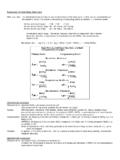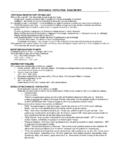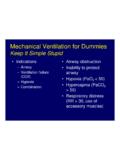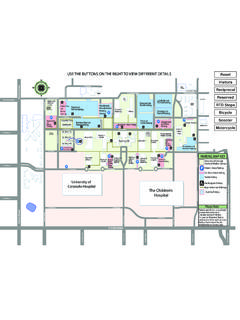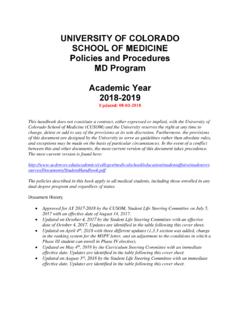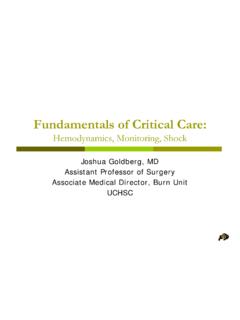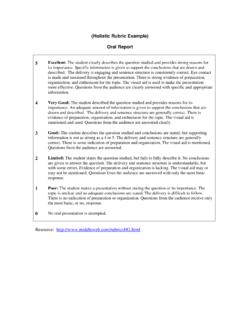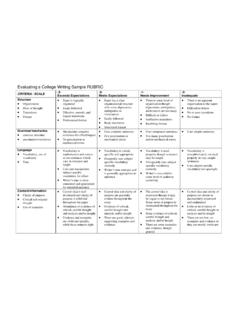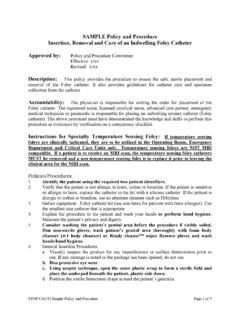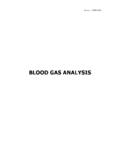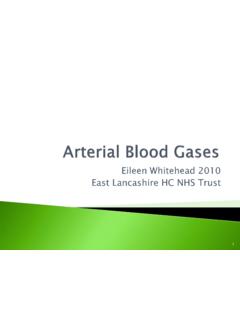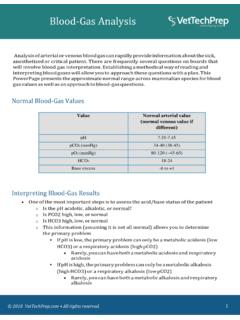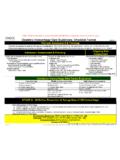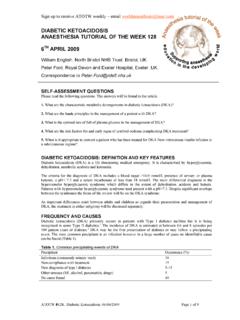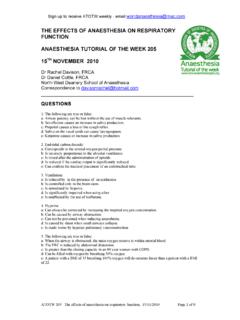Transcription of Rules on Oxygen Therapy - Denver, Colorado
1 Rules on Oxygen Therapy : Physiology: 1. PO2, SaO2, CaO2 are all related but different. 2. PaO2 is a sensitive and non-specific indicator of the lungs ability to exchange gases with the atmosphere. 3. FIO2 is the same at all altitudes 4. Normal PaO2 decreases with age 5. The body does not store Oxygen Therapy & Diagnosis: 1. Supplemental O2 is an FIO2 > 21% and is a drug. 2. A reduced PaO2 is a non-specific finding. 3. A normal PaO2 and alveolar-arterial PO2 difference (A-a gradient) do NOT rule out pulmonary embolism. 4. High FIO2 doesn t affect COPD hypoxic drive 5.
2 A given liter flow rate of nasal O2 does not equal any specific FIO2. 6. Face masks cannot deliver 100% Oxygen unless there is a tight seal. 7. No need to humidify if flow of 4 LPM or less Indications for Oxygen Therapy : 1. Hypoxemia 2. Increased work of breathing 3. Increased myocardial work 4. Pulmonary hypertension Delivery Devices: 1. Nasal Cannula a. 1 6 LPM b. FIO2 (approx 4% per liter flow) c. FIO2 decreases as Ve increases 2. Simple Mask a. 5 8 LPM b. FIO2 (approx 4% per liter flow) c. Minimum flow 5 LPM to flush CO2 from mask 3.
3 Venturi Mask a. Variable LPM b. FIO2 c. Flow and corresponding FIO2 varies by manufacturer 4. Partial Rebreather a. 6 10 LPM b. FIO2 c. Flow must be sufficient to keep reservoir bag from deflating upon inspiration 5. Nonrebreather a. 6 10 LPM b. FIO2 c. Flow must be sufficient to keep reservoir bag from deflating upon inspiration 6. With the exception of the Venti mask, the above are all low flow Oxygen delivery systems and therefore the exact FiO2 will be based on the patient's anatomic reservoir and minute ventilation. 1.
4 PO2 , SaO2 , CaO2 are all related but different. PaO2, the partial pressure of Oxygen in the arterial blood, is determined solely by the pressure of inhaled Oxygen (the PIO2), the PaCO2, and the architecture of the lungs. The most common physiologic disturbance of lung architecture is ventilation-perfusion (V-Q) abnormality; less commonly, there can be diffusion block or anatomic right to left shunts. If the lungs are normal, then PaO2 is affected only by the alveolar PO2 (PAO2), which is determined by the fraction of inspired Oxygen , the barometric pressure and the PaCO2 ( , the alveolar gas equation).
5 PaO2 is a major determinant of SaO2, and the relationship is the familiar sigmoid-shaped Oxygen dissociation curve. SaO2 is the percentage of available binding sites on hemoglobin that are bound with Oxygen in arterial blood. The O2 dissociation curve (and hence the SaO2 for a given PaO2) is affected by PaCO2, body temperature, pH and other factors. However, SaO2 is unaffected by the content of hemoglobin, so anemia does not affect SaO2. CaO2 is arterial Oxygen content. Unlike either PaO2 or SaO2, the value of CaO2 directly reflects the total number of Oxygen molecules in arterial blood, both bound and unbound to hemoglobin.
6 CaO2 depends on the hemoglobin content, SaO2, and the amount of dissolved Oxygen . Units for CaO2 are ml Oxygen /100 ml blood (see below). 2. PaO2 is a sensitive and non-specific indicator of the lungs' ability to exchange gases with the atmosphere. In patients breathing ambient or "room" air (FIO2 = .21), a decreased PaO2 indicates impairment in the gas exchange properties of the lungs, usually signifying V-Q imbalance. PaO2 is a very sensitive indicator of gas exchange impairment; it can be reduced from virtually any parenchymal lung problem, including asthma, chronic obstructive pulmonary disease, and atelectasis that doesn't show up on a chest x-ray.
7 3. FIO2 is the same at all altitudes. The percentage of individual gases in air ( Oxygen , nitrogen, etc.) doesn't change with altitude, but the atmospheric (or barometric) pressure does. FIO2, the fraction of inspired Oxygen in the air, is thus 21% (or .21) throughout the breathable atmosphere. PaO2 declines with altitude because the inspired Oxygen pressure declines with altitude (inspired Oxygen pressure is fraction of Oxygen times the atmospheric pressure). Average barometric pressure at sea level is 760 mm Hg; it has been measured at 253 mm Hg on the top of Mt.
8 Everest. 4. Normal PaO2 decreases with age. A patient over age 70 may have a normal PaO2 around 70-80 mm Hg, at sea level. A useful rule of thumb is normal PaO2 at sea level (in mm Hg) = 100 minus the number of years over age 40. 5. The body does not store Oxygen . If a patient needs supplemental Oxygen it should be for a specific physiologic need, , hypoxemia during sleep or exercise, or even continuously (24 hours a day) as in some patients with severe, chronic lung disease. 6. Supplemental O2 is an FIO2 > 21%. Supplemental Oxygen means an FIO2 greater than the 21% Oxygen in room (ambient) air.
9 When you give supplemental Oxygen you are raising the patient's inhaled FIO2 to something over 21%; the highest FIO2 possible is 100%. To give more Oxygen requires a hyperbaric chamber. 7. A reduced PaO2 is a non-specific finding. It can occur from any parenchymal lung problem, and only signifies a disturbance of gas exchange (usually due to V/Q imbalance). A low PaO2 should not be used to make any particular diagnosis, including pulmonary embolism. 8. A normal PaO2 and Alveolar-arterial PO2 difference (A-a gradient) do not rule out pulmonary embolism.
10 About 5% of confirmed cases of PE manifest a normal A-a gradient. 9. High FIO2 doesn't affect COPD hypoxic drive. The reason a high FIO2 may raise PaCO2 in a patient with COPD is not because the extra Oxygen cuts off the hypoxic drive. Modest rise in PaCO2 occurs mainly because the extra Oxygen alters V/Q relationships within the lungs, creating more physiologic dead space. 10. A given liter flow rate of nasal O2 does not = any specific FIO2. The oft-quoted rule that 2 l/min =an FIO2 of 24%, 3 l/min = 28%, etc., is an illusion, based on nothing experimental or scientific.
